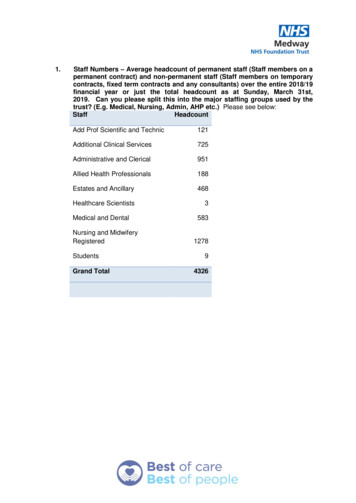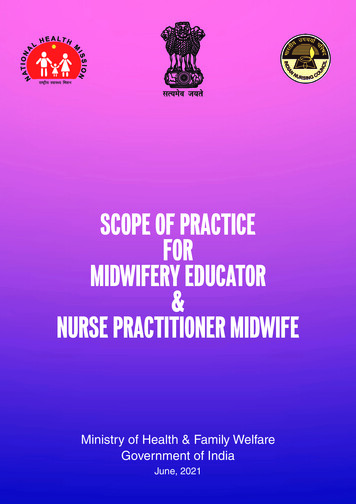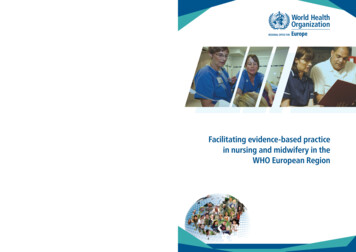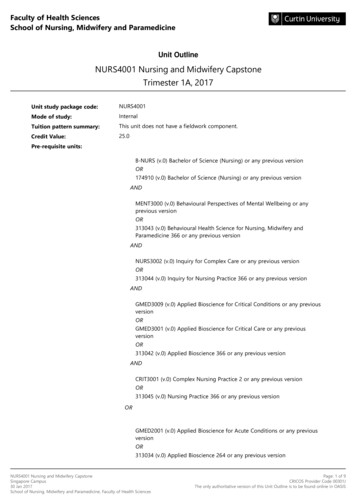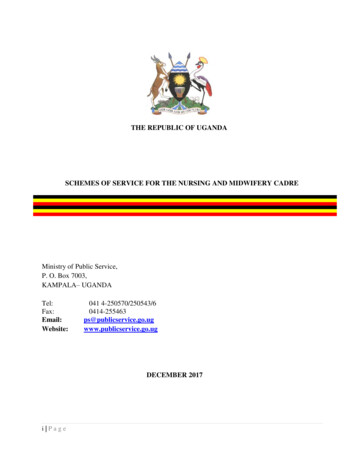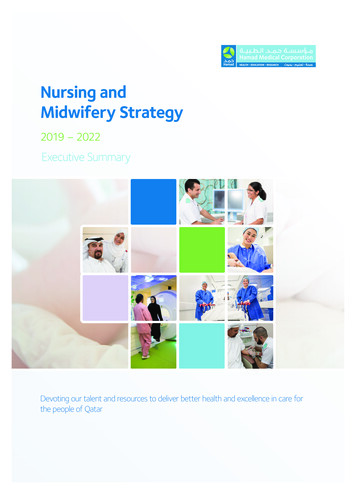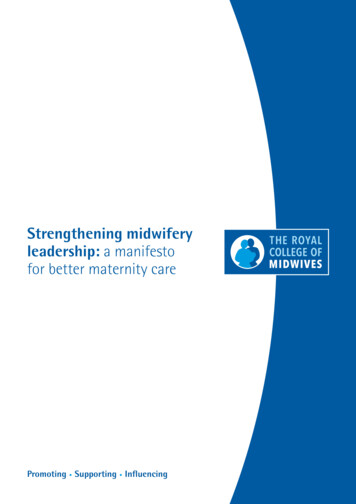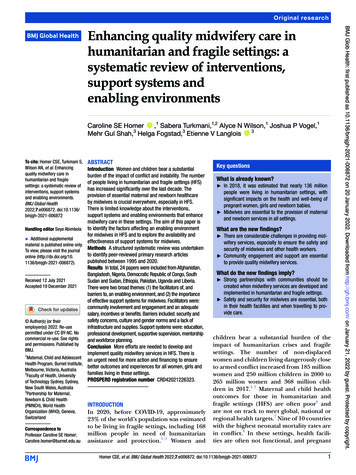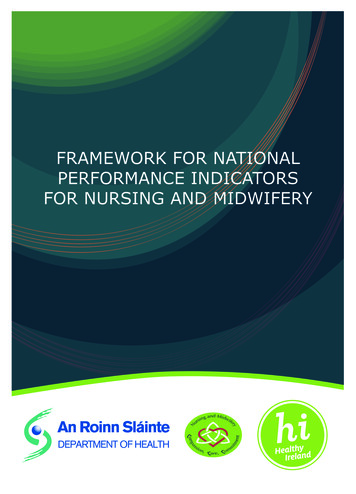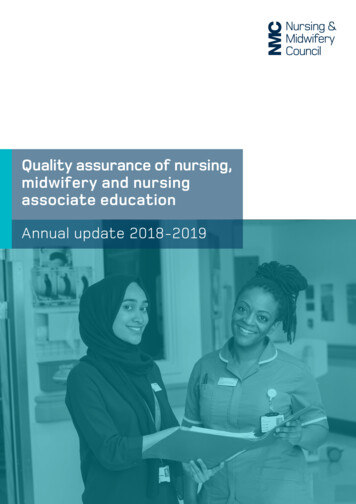
Transcription
Quality assurance of nursing,midwifery and nursingassociate educationAnnual update 2018-20191Quality assurance of nursing and midwifery education Annual update 2018–2019
What we doWe’re the independent regulator for nurses, midwives and nursing associates.We hold a register of around 700,000 nurses, midwives and nursing associateswho can practise in the UK.Better and safer care for people is at the heart of what we do, supportingthe healthcare professionals on our register to deliver the highest standardsof care.We make sure nurses, midwives and nursing associates have the skillsthey need to care for people safely, with integrity, expertise, respect andcompassion, from the moment they step into their first job.Learning does not stop the day nurses, midwives and nursing associatesqualify. To promote safety and public trust, we require professionals todemonstrate throughout their career that they are committed to learningand developing to keep their skills up to date and improve as practitioners.We want to encourage openness and learning among healthcare professionsto improve care and keep the public safe. On the occasions when somethinggoes wrong and people are at risk, we can step in to investigate and takeaction, giving patients and families a voice as we do so.
ContentsForeword4Executive summary5Introduction6Part one: approval of nursing, midwifery andnursing associate education programmes7Part two: monitoring and concerns15Part three: responding to concerns173Quality assurance of nursing and midwifery education Annual update 2018–2019
ForewordI am pleased to present our annual update on our education quality assurance (QA)activity for the 2018–19 academic year, covering the QA of nursing, midwifery and nursingassociate education.This has been an exceptionally important and busy year for our QA activity. With theintroduction of our new education standards last year and having become the regulatorfor nursing associates, we have begun the process of approving every institution andprogramme against these outcomes-focused standards through our new gateways-basedapproach to approval.The new gateways approach has removed the need for institutions to first become anapproved education institution (AEI) before seeking approval of a programme. Institutionsnow undertake a more streamlined process to achieve both at once. People are at thecentre of our QA activity, and under our new QA Framework we have now introduced layvisitors to work alongside our registrant visitors on all pre-registration approvals to ensurethat the service user voice is appropriately reflected. We also require people who useservices and carers who have been involved in developing the programmes at institutions tobe present at approval events.Having introduced our new QA Framework and approach last year we have liaised closelywith the sector, including the Council of Deans of Health to seek their feedback on ourapproach, and have actively made changes in response to feedback to ensure we are beingproportionate, targeted and robust.Alongside approval of programmes we have continued to develop our data driven approachto monitoring institutions which we will operationalise next year. This will enable us tobe more targeted in the way in which we make regulatory interventions whilst takingappropriate action to work with AEIs and their practice learning partners where we haveconcerns, and reducing regulatory burden.Professor Geraldine Walters, CBEDirector of Education and Standards4Quality assurance of nursing and midwifery education Annual update 2018–2019
Executivesummary1. Our quality assurance (QA) framework is one of the ways that we ensure better, safercare. Each year we reflect and report on the outcomes of our QA activity to ensure thatstudents are being equipped with the relevant knowledge, skills and learning experienceto practise safely at the time they join the register and that they can build on throughouttheir career. We also continuously look for ways to improve our approach to QA byimproving our processes.2. At the time of writing this report, the number of approved education institutions(AEIs) had increased from 83 to 86, covering 1,087 approved programmes. This year 56institutions have sought approval for programmes under our new standards.3. Alongside programme approval we continue to monitor institutions through our annualself-reporting process and concerns mechanisms. Of the 82 AEIs who had been approvedfor over a year and therefore were required to undergo annual self-reporting, 21 didnot initially provide assurance that our standards were being met. However, this wasdue to not appropriately updating us on changes that had been made as a result ofrecommendations at approval events or updating us on open concerns cases rather thana failure in learning or care. After resubmission all 82 institutions provided assurance.4. We continue to monitor institutions throughout the year, and make regulatoryinterventions where we have concerns. We are proactive in making the best possible useof our intelligence by promoting information sharing and collaborating both internallywith our Regulatory Intelligence Unit and Employer Link Service, and externally with otherregulators and key organisations5Quality assurance of nursing and midwifery education Annual update 2018–2019
Introduction5. The Nursing and Midwifery Order 2001 (the Order) sets the legislative context for theQA of nursing, midwifery and nursing associate education. Our standards comply withour legislation and provide necessary requirements for the education and training ofnurses, midwives and nursing associates, and the proficiencies they have to meet to joinour register.6. This annual update examines the QA activity we have undertaken and the key themesand risks that have emerged from our QA of approved education institutions and theirpractice placement partners in the 2018–19 academic reporting year (from 1 September2018 to 31 August 2019) for nursing, midwifery and nursing associate education.7. Our role in education plays a very important part in how we meet our overall objective ofbetter, safer care. In the 2018–19 academic reporting year our QA of education comprisedof three key activities. Approval of education institutions and education programmes. Annual self-reporting. Responding to concerns.8. Last year we published our new standards for nursing and midwifery education, as well asa new QA Framework, outlining changes to the way in which we quality assure institutions.6Quality assurance of nursing and midwifery education Annual update 2018–2019
Part one:approval of nursing, midwiferyand nursing associateeducation programmes9. Under our QA Framework (2018) education institutions no longer have to firstobtain approved education institution (AEI) status before seeking approval of theirprogrammes. This process has now been streamlined into one gateway process, whereapproval of the institution is granted at the same time as approval of a programme.Documentary analysisPart One:Mappingagainststandardsframeworkfor nursingand midwiferyeducationPASSGateway 2Part Two:Standardsfor studentssupervision andassessmentGateway 3Part Three:ProgrammestandardsPASSGateway 4VisitsFormal NMC approvalApproval requestGateway 1PASSVisitior reportPASSApproval of education institutions10. There are currently 86 AEIs across the UK, with three new AEIs being approved duringthe period of 1 September 2018 to 31 August 2019: University of Roehampton, Universityof Winchester and University of Aberdeen.11. A summary of AEIs and approved programmes has been included in table one. A full list ofall AEIs is shown in table two.7Quality assurance of nursing and midwifery education Annual update 2018–2019
Table one – AEI summary dataTotal number of NMC AEIsTotal number of NMC approved programmes8861,087Number of AEIs approved to run pre-registration nursingprogrammes against pre-2018 standards80Number of AEIs approved to run pre-registration nursingprogrammes against 2018 standards37Number of AEIs approved to run pre-registration midwiferyprogrammes55Number of new education institutions approved to be an AEI duringthe reporting year3Number of AEIs approved to deliver pre-registration nursing for thefirst time3Number of AEIs approved to deliver pre-registration midwifery forthe first time2Number of AEIs approved to deliver pre-registration nursingassociates32Quality assurance of nursing and midwifery education Annual update 2018–2019
Table two – List of approved education institutions and those undernew programme monitoring*New institutionNew programme monitoringENGLANDOxford Brookes UniversityAnglia Ruskin UniversityUniversity of PlymouthUniversity of BedfordshireUniversity of PortsmouthBirmingham City UniversityUniversity of ReadingUniversity of BirminghamUniversity of Roehampton*University of BoltonUniversity of SalfordBournemouth UniversitySheffield Hallam UniversityBPPUniversity of SheffieldUniversity of BradfordSouthampton Solent UniversityUniversity of BrightonUniversity of SouthamptonBrunel University LondonStaffordshire UniversityBuckinghamshire New UniversityCanterbury Christ Church UniversityUniversity of Central LancashireUniversity of ChesterCity University LondonCoventry UniversityUniversity of CumbriaDe Montfort UniversityUniversity of DerbyUniversity of East AngliaUniversity of East LondonSuffolk, University of (formerly University Campus Suffolk)University of SunderlandUniversity of SurreyTeesside UniversityUniversity of West LondonUniversity of West of England in BristolUniversity of Winchester*University of WolverhamptonUniversity of WorcesterUniversity of YorkEdge Hill UniversityUniversity of EssexUniversity of ExeterUniversity of GloucestershireNORTHERN IRELANDQueens University BelfastUniversity of Ulster at JordanstownUniversity of GreenwichUniversity of HertfordshireUniversity of HuddersfieldSCOTLANDUniversity of Aberdeen*University of HullUniversity of Abertay DundeeKeele UniversityUniversity of DundeeKing’s College LondonEdinburgh Napier UniversityKingston University & St George’s University of LondonGlasgow Caledonian UniversityLeeds Beckett UniversityUniversity of EdinburghUniversity of LeedsUniversity of GlasgowUniversity of LeicesterUniversity of Highlands and IslandsUniversity of LincolnQueen Margaret UniversityLiverpool John Moores UniversityRobert Gordon UniversityUniversity of LiverpoolUniversity of StirlingLondon South Bank UniversityUniversity of West of ScotlandManchester Metropolitan University9University of ManchesterWALESMiddlesex UniversityBangor University, School of Healthcare SciencesUniversity of NorthamptonUniversity of CardiffNorthumbria UniversityUniversity of GlyndwrUniversity of NottinghamUniversity of South WalesThe Open UniversitySwansea UniversityQuality assurance of nursing and midwifery education Annual update 2018–2019
Approval of education programmes12. The largest amount of activity this year has been approving institutions against the newframework for nursing and midwifery education and the nursing, nursing associate andprescribing programme standards in England with institutions in Wales, Scotland andNorthern Ireland having opted for approval in 2020. These approvals were done throughthe gateways process outlined above. At each gateway the submitted documentationis reviewed by the visitors to ensure our standards are met. A summary of gatewaysubmissions has been included as table three.Table three – Approvals through gateways one and two by institutionsTOTAL NUMBER OF PROGRAMMESTotalnumber ofinstitutionsNARNPrescribingEIs who submitted Gateway one56EIs who had Gateway one rejected initially20EIs who submitted Gateway two54EIs who had Gateway two rejected initially23201714EIs who had Gateway three rejected initially6332EIs who have had a Gateway four approval visit5435442613. 56 institutions submitted Gateway one for an approval visit during the 2018–19 academicyear. 36 institutions met Gateway one: Standards framework for nursing and midwiferyeducation on the first submission. 20 institutions were rejected due to insufficientevidence to meet the standards, in particular due to lack of documentary or narrativeevidence to support how the standards would be met. Of these 20, 18 met all thestandards on re-submission, and two institutions have deferred their approval visitsuntil the next academic year.14. Of the 54 institutions who successfully passed Gateway one, 23 institutions coveringmultiple programmes were initially rejected at Gateway two: Standards for studentsupervision and assessment due to lack of evidence or narrative. All of theseinstitutions passed Gateway two after resubmitting the evidence.15. At Gateway three, six education institutions were initially rejected covering eightprogrammes, seven programmes have since re-submitted, and had their Gateway fourapproval visits, and one has deferred their approval for that programme until 2020.10 Quality assurance of nursing and midwifery education Annual update 2018–2019
16. At Gateway four, for the 54 institutions who had visits, this covered 105 different courses.The recommended outcomes of these programmes include: 10 recommended for approval;93 recommended for approval after conditions were met; and, two recommended forrefusal of approval. Further information on conditions can be found below.17. Where themes have been identified for rejections at the different gateways we haveshared lessons learned with the sector through webinars, and presentations as welldeveloping supporting information which is published on our website.18. Alongside the approval of programmes against the new standards, three new providersfor midwifery programmes were also approved: University of Highlands and Islands,University of Bolton and the University of Lincoln. An SPQ District Nursing programmewas also approved at London South Bank University.19. We continue to monitor approvals of programmes and we are on target to meet our keyperformance indicator (KPI) for number of AEIs approved against the new standards thisyear. Our external KPI for making a decision around programme approval once we havereceived the visitors’ report is 20 days. We have met this 100 percent, with the averagetime being only seven days.Nursing associates20. In October 2018 we published the Standards for pre-registration nursing associateprogrammes. Due to the delay in the Institute for Apprenticeships publishing theapprenticeship standard for nursing associates we saw a number of institutions defertheir initial requested visit dates. However, we have had 35 programme approval visits,with 32 programmes being approved and one programme being recommended forrefusal. The remaining institutions are currently meeting their conditions. There arecurrently a further 20 institutions seeking approval of a nursing associate programme.We continue to liaise closely with the Department for Health and Social Care and HealthEducation England in relation to the number of nursing associate approvals.21. Due to the delay in the apprenticeship standard being published by the Institute forApprenticeships we appreciate that this increased the urgency in relation to thetimelines of approvals to allow programmes to start. We have therefore been verymindful of this and have taken steps to ensure that we turnaround final decisions quickly– on average we have responded within seven days of the approval report being received,compared to our published KPI of 20 days, which has been met 100 percent.11Quality assurance of nursing and midwifery education Annual update 2018–2019
Degree apprenticeships22. We have continued to see an increase in demand for degree apprenticeship routesto our register. During the 2018–19 academic year a further 11 institutions are nowdelivering nursing degree apprenticeships, bringing the total to 34.23. Out of the 32 approved nursing associate programmes, 29 have been approved withapprenticeship routes.24. Three visits also took place to approve midwifery degree apprentice (MDA) routesin approved midwifery programmes. These took place in the higher education pilotsites that were selected by Health Education England (HEE): University of Greenwich,University of West London and University of Bedfordshire.Conditions25. Where visitors identify that our standards are not met, they can either set conditions,or where significant concerns are raised recommend refusal of the programme. Theinstitution must meet these conditions, which are approved by the visitor before we willapprove the programme.26. Conditions are categorised against five key risk themes. In order of the most frequentlyoccurring conditions the risk themes were: Selection, admission and progression. Effective partnership working: collaboration, culture, communication and resources. Practice learning. Assessment, fitness for practice and award. Education governance: management and quality assurance.27. The conditions set during this period included the following: Appropriate patient and service user involvement in selection and admission. Effective and robust collaboration with practice learning partners. Clarification of recognition of prior learning processes. Sufficient academic and practice partner resource. Explicit information on how the programme is run, including assessment. Ensuring consistent programme documentation.28. In table four, we have summarised all conditions assigned to AEIs following approvalevents within the 2018–2019 academic year.12 Quality assurance of nursing and midwifery education Annual update 2018–2019
Table four (A) – Summary of programme approvals and majormodifications with mesrecommended forapproval withoutconditions69519138321Programmesrecommended forapproval afterconditions were met11431422610203Programmerecommended forrefusal21100000Table four (B) – Total number of conditions at approval eventsagainst key risk themesKey risk themeTotalSelection, admission and progression59Effective partnership working: collaboration, culture, communication and resources47Practice learning46Assessment, fitness for practice and award34Education governance: management and quality assurance31Refusals29. Visitors have currently recommended two programmes for refusal – one nursingassociate, and one nursing programme. Where we receive a recommendation to refusea programme, the institution can make observations on the report before we receive it.The QA Board then reviews the evidence. Where we are minded to refuse the programmethe institution then has a further calendar month to make any additional observationsbefore we make a final decision.30. Should concerns be raised in relation to current students we would liaise closely with theAEI to ensure appropriate measures have been put in place.13 Quality assurance of nursing and midwifery education Annual update 2018–2019
Stakeholder engagement and changes to our processes31. We continually work with AEIs to review our QA activity to ensure that it is appropriate,proportionate, targeted and transparent. We routinely work with different stakeholdersto gather their viewpoints including a survey of every AEI which has gone throughapproval. The themes emerging from this survey are considered quarterly at the QABoard. Alongside surveys we have also held a number of round table events with theCouncil of Deans of Health in the different countries and worked closely with them torespond to any feedback.32. As we introduced a new QA Framework in 2018 we have made a number of changesto our processes in response to feedback: Improved communication targeted at institutions seeking NMC approval forthe first time. Provided increased clarity during the gateway approval process that institutionscould sign-post between standards and evidence rather than duplicating theirsubmissions. Introduced a new streamlined targeted process for institutions to add newemployer apprenticeship partners on approved apprenticeship programmes. Developed further supporting information for the sector on our website, alongsidesharing key themes for institutions being rejected at the different gateways to helpinform future approval activity.14 Quality assurance of nursing and midwifery education Annual update 2018–2019
Part two:monitoring and concernsAnnual self-reporting33. AEIs are required to undertake and submit an annual self-assessment and self-declarationof their current NMC approved programme(s). The self-assessment provides anopportunity for AEIs and their practice learning partners to give examples or case studiesof notable or innovative practice, and enables them to indicate any areas of provisionthat they are aiming to enhance. The self-declaration requires the AEI to confirm thatall approved programmes continue to meet the NMC standards; that all programmemodifications have been notified to the NMC; and, that all key risks are controlled.34. The AEI annual self-assessment reports are reviewed and we may require AEIs toresubmit their report and provide further detailed evaluative information if the evidenceprovided cannot assure us that all criteria have been met.35. All 82 AEIs, who had been approved for more than a year, and were therefore requiredto undertake annual self-reporting at the time, submitted their self-assessmentreports for the 2018–19 reporting year. The University of Exeter, a new AEI, submitteda self-assessment report, however NMC programme delivery did not commenceuntil September 2019. 21 AEIs (26 percent) did not provide assurance in their selfassessment report that key risks were controlled or managed. This is an increase fromthe previous year’s outcome which was 16 percent.36. Whilst there was an increase in institutions not providing assurance, the principle reasonwas the failure to report details on action(s) taken to address the recommendation(s)from programme approval/modification events held between 1 September 2017 and 31August 2018. This was the case for 17 out of 82 AEIs. The remaining four institutions didnot provide updates on open concerns cases.37. The 21 AEIs resubmitted their self-assessment reports, which have been reviewed andassurance is now provided that NMC key risks are controlled or mitigated in 2018–19.38. 75 AEIs provided a variety of examples of good practice. One particular example whichmet our criteria of notable or innovative practice is from London South Bank Universitywhere they run hearing loss workshops which are co-produced with people who useservices and students to ensure sensory deprivation is thoroughly embedded in NMCcurricula. Next year we will be hosting a number of webinars to share the good practiceidentified with the sector.15 Quality assurance of nursing and midwifery education Annual update 2018–2019
New programme monitoring and enhanced scrutiny39. As we move towards a data driven approach to QA we have introduced a period ofnew programme monitoring for all new AEIs, or existing AEIs running a new preregistration programme. New programme monitoring lasts until the first studentsfrom the programme join our register. This gives us the opportunity to work moreclosely with new programmes and institutions who we have not worked with before, andtherefore have less information on to inform our data driven approach. As part of newprogramme monitoring programmes must submit self-reports to us twice a year, bothof which are followed up by a telephone call by a member of the QA team. In 2018–19,36 institutions were placed under new programme monitoring covering 32 nursingassociate programmes, three nursing programmes and one new AEI not yet running apre-registration programme. A summary table of institutions under new programmemonitoring has been included in table two. The first new programme monitoring will takeplace from November 2019.40. As part of the new data driven approach to monitoring institutions, which will beimplemented more fully next year, we have also introduced a similar process to newprogramme monitoring for currently approved programmes referred to as enhancedscrutiny. Enhanced scrutiny will be applied where we have concerns based on the data wehave – for example if there is a trend that over time student attrition on a programme iscontinuing to increase. In 2018–19 no programmes were placed under enhanced scrutiny.16 Quality assurance of nursing and midwifery education Annual update 2018–2019
Part three:responding to concerns41. We continue to monitor AEIs and their practice learning partners to ensure compliancewith our standards. When risks emerge AEIs and their practice learning partners mustrespond swiftly to manage and control risks appropriately. AEIs should email exceptionalreports to us and we take action when these risks are not being effectively managedand controlled locally. We also gather intelligence directly from system regulators, mediascanning and whistleblowing, as well as through our Regulatory Intelligence Unit (RIU).42. Once we receive a concern through any of those methods they are then graded as: minor – risks to our standards not being met are minimal and unlikely to impact onthe student learning environment and public safety moderate – risks to our standards not being met with possible impact on the studentlearning environment and public safety major – risks to our standards not being met are high with possible impact on thestudent learning environment and public safety critical – risks to our standards not being met are high with potential significantimpact on the student learning environment and public safety.43. During 2018–19 we received a total of 109 concerns, with 65 being categorised asminor, 36 as moderate, five as major and three as critical. A full summary of concernscan be found in table five. In the table we note where the concern has first been raisedwith us, and whilst a large proportion are from our RIU rather than initially from theAEI directly, this is primarily due to the efficiency of the RIU in highlighting concerns. Inthese circumstances we routinely subsequently also receive an exceptional report fromthe AEI to highlight the same concerns and their actions as we would expect. Where wedo not hear from the AEIs involved we follow this up with them and remind them of ourexpectations. In the future institutions failing to exceptionally report areas of identifiedconcern will be monitored as part of our data driven approach to QA, and could be placedunder enhanced scrutiny.44. Similarly to previous years, most of the exceptional reports continue to relate to issuesin practice environments, including adverse system regulator reports and their impacton student learning, supervision and assessment and escalation of student concerns,and what actions have been undertaken locally to manage those concerns.17Quality assurance of nursing and midwifery education Annual update 2018–2019
45. Once a concern has been categorised there are a number of different regulatoryinterventions we can take to ensure the programmes continue to meet our standardsranging from no further action where we have sufficient assurance from the institution,through to carrying out an extraordinary review, which can lead to us withdrawing approvalof a programme. A summary of regulatory interventions can be found in Annexe five.46. Where we identify serious adverse incidents and concerns regarding an AEI or practiceplacement and local risk measures are limited, we may decide to conduct an unscheduledextraordinary review. This measure may be necessary if there are concerns that presenta risk to public protection, and if it is deemed that the AEI is either unaware or unableto put adequate measure in place to control the risk. No new extraordinary reviews tookplace during the 2018–2019 academic year. For the three critical items currently open,all have had regular calls from the senior team, with two having multiple face to facemeetings, including with other regulators and government bodies to secure ongoingassurance. This ongoing assurance has also involved requesting appropriate action plans,and contingency plans for removing students. The critical items are reviewed monthly atour internal QA Board.47. As part of our role as a dynamic regulator, we continue to proactively share intelligenceinternally with our Regulatory Intelligence Unit and Fitness to Practise colleagues as wellas externally where appropriate with other professional and system regulatorsTable five (A) – Number of concerns opened by source of concernand nningWhistleblowingRegulatoryIntelligence 5Critical002013109Table five (B) – Regulatory interventions taken for concernsClosedwith nofurtheractionEmail forclarificationCallfrom QAofficerActionplanrequestedCall fromSeniorTeamFaceto 918 Quality assurance of nursing and midwifery education Annual update 2018–2019
23PortlandPlace,Place,LondonLondonW1B1PZ23 PortlandW1B1PZT 44 20207637763771817181 F 44 20 7436 2924www.nmc.org.ukwww.nmc-uk.orgThe nursing and midwifery regulator for England,Wales, Scotland, andNorthernIrelandand the IslandsNorthernIrelandRegistered charity in England and Wales (1091434) and in Scotland (SC038362)
4 Quality assurance of nursing and midwifery education Annual update 2018-2019 . I am pleased to present our annual update on our education quality assurance (QA) activity for the 2018-19 academic year, covering the QA of nursing, midwifery and nursing associate education.
